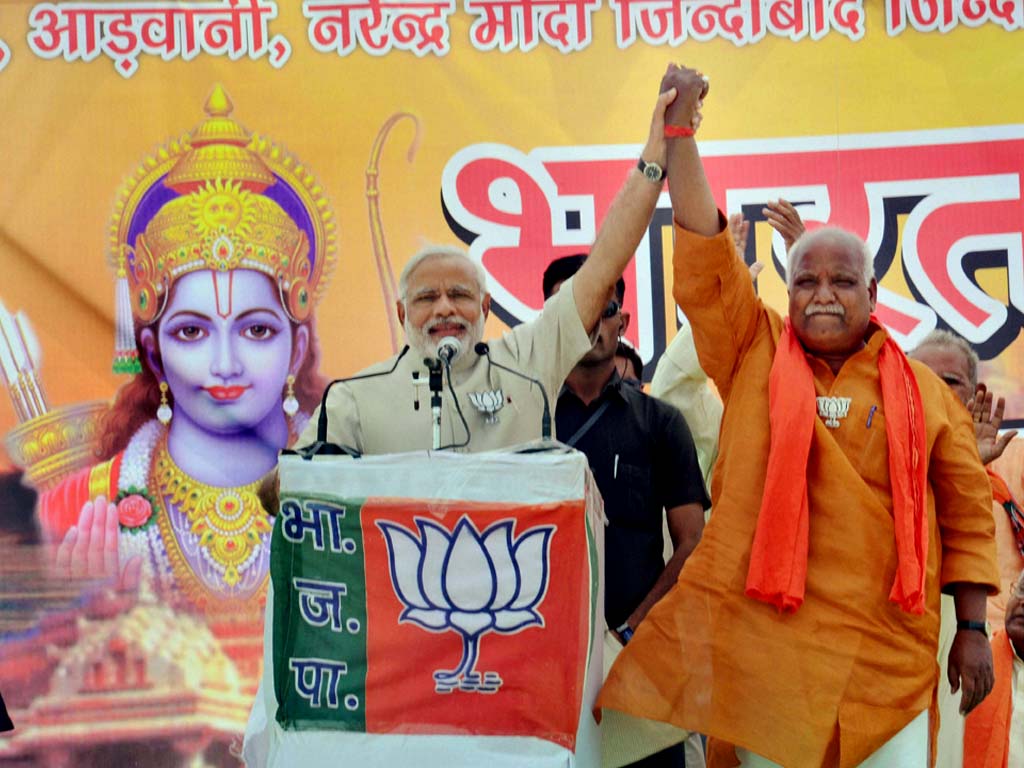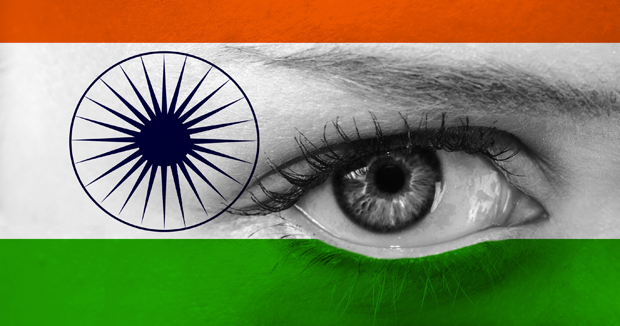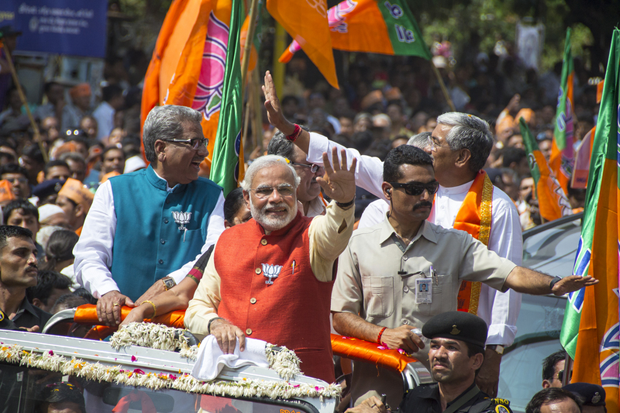Index relies entirely on the support of donors and readers to do its work.
Help us keep amplifying censored voices today.

Modi invoked Lord Ram while addressing a meeting in Faizabad, barely six kilometres from Ayodhya. He shared the stage with the Faizabad candidate Lalu Singh who was issued a notice by the EC for displaying religious portraits.
“The Ram- Rahim ideal and the secular ideology are often the stuff of an Indian politician’s election haberdashery, not his soul-stuff.” Justice Krishna Iyer of India’s Supreme Court was scathing in his criticism of those electoral candidates who canvass votes in the name of religion or by instigating polarisation among different religious and ethnic communities. Besides violating India elections law, they also damage the country’s secular fabric.
The law is Section 123(3) of the Representation of the People Act, which deems candidates’ or their agents’ appeal for votes on the basis of religion or religious symbols as a “corrupt practice”, and if found guilty, entails disqualification.
On May 6, while campaigning for Lalloo Singh, the Bharatiya Janata Party’s (BJP) candidate from Faizabad, Narendra Modi, with the picture of Ram, a mythological king of ancient India, revered as a god by the Hindus, adorning the background, promised to bring about “Ram Rajya” (kingdom of Ram) if voted into power. The Election Commission was quick to order an investigation for a violation of the election law as well as the Model Code of Conduct–a set of guidelines which aren’t legally binding.
As it has become de rigueur for a Hindu Right party like the BJP, bellicose arguments about violation of the fundamental rights to freedom of religion and freedom of expression were relentlessly trotted out. The truth is quite different, because the Supreme Court has held that the restriction on religious electioneering doesn’t impinge upon any such right.
When the constitutional validity of Section 123 (3) was challenged in 1954, a bench of five Supreme Court judges while upholding the provision held that it does not prevent a man from speaking and merely prescribes conditions which must be observed if he wants to enter parliament. The right to contest an election is not a common law right but a special right created by a statute and the statutory provisions have no bearing on the fundamental rights. Then when a similar challenge was mounted again in 1965, the court affirmed its earlier decision and stated that the law acted as a wedge against the secular, democratic process being vitiated by bigotry and violence. It must be mentioned that both these judgements hold ground to this day.
Going back to Modi’s speech, take a look at the photograph, and some more facts. “Ram Rajya”, which the BJP so desperately tried to pass off as a moniker for good governance, is an exclusive Hindu term, and no one professing any other faith would ever use that expression. The setting in which the speech was delivered makes Modi’s actions all the more egregious. He was speaking at Faizabad in Uttar Pradesh, which is only a stone’s throw away from Ayodhya, which has attained permanent notoriety for the site of the demolition of the Babri Mosque in 1992 by hordes of militant Hindus swearing fanatical allegiance to the BJP and its associated parties. In fact 6 December 1992 marks that watershed moment when communalism became an inalienable and vicious part of Indian politics. Things have only slid downhill from there, and who can forget the carnage in Gujarat in 2002 (under Narendra Modi’s watch)?
And the fact that Lalloo Singh is one of those arraigned as accused for razing the mosque to the ground leaves no one in any doubt as to Modi’s real agenda- to whip up Hindu communal passions and garner as many votes as possible.
Modi’s increasingly strident bigotry has bared its fangs open in the last lap of the election campaign. Only on May 5, he tried to charm his Uttar Pradesh supporters by thundering that only those who worship Durga–a Hindu goddess–are true Indians, and all Muslim migrants will be deported once he came to power.
It remains a mystery and one of grave consternation as to why the Election Commission finally went easy and took no action. But a fitting reply to the last Modi apologist would be -the promise of building a Ram temple over the pulverized mosque occupies pride of place in the BJP’s election manifesto.
This article was posted on May 15, 2014 at indexoncensorship.org

(Photo illustration: Shutterstock)
The cauldron has always been simmering, despite abundant shibboleths about this election not being about hate or Hindutva (the communal political ideology of the Hindu Right wing) but about development.
Therefore it came as no surprise when on 19 April, the Vishwa Hindu Parishad’s (VHP) International President Praveen Togadia exhorted a mob in Bhavnagar to storm a house which had recently been purchased by a Muslim businessman. And in case he refused to vacate the house within 48 hours, Togadia raged, go after him with stones and tyres. After all, since those who went on the rampage in the 1984 Delhi riots have enjoyed impunity, there’s nothing to fear, he thundered. Ram Madhav, a senior functionary of the RSS (Rashtriya Swayamsevak Sangh), stoutly defended Togadia. But the Bharatiya Janata Party (BJP) and its prime ministerial candidate Narendra Modi have remain tight-lipped about the entire affair.
It is unfortunate, alarming, but true that hate propaganda has always yielded rich political dividends, and the BJP and its allies of the Hindu right have been frontrunners in making the most of it. If that wasn’t bad enough, the Election Commission, the supreme authority in charge of managing and conducting polls, has been woefully inept at dealing with this malaise. Consider this, Amit Shah, Modi’s henchman and campaign manager, got away with a mere censure after egging on people in riot-torn Muzaffarnagar to vote for the BJP if they wanted revenge on Muslims.
The fault doesn’t lie with the Election Commission, though. It is the lacunae in the laws which allow the purveyors of hate and bigotry to have a free hand. India’s election law prescribes a “Model Code of Conduct” which prohibits incendiary speeches, especially those pandering to religion and seeking to stir up communal violence. But mere prohibition, without adequate authority for imposing meaningful punishment which acts as a deterrent, is not of much use. And it is here where the commission’s hands are tied. The code does not have any legal teeth, so a candidate caught delivering hate speeches cannot be debarred. For instance, in 2009, Modi had a crowd baying for the blood of Muslims, but the commission’s chief stated that he couldn’t do much except “rebuke”.
The cynical subterfuge adopted by political parties aggravates the situation. Immediate legal action is ruled out, since the law permits a candidate’s election to be challenged only after the results are declared, thereby giving ample opportunity to the poisonous tree of hate to bear its bitter fruit. In the meanwhile, the offenders parrot vehement denials, knowing very well that dilatory tactics only work in their favour. Modi did it 2002, engaging in protracted sparring with the Indian Supreme Court, and in 2007, the BJP’s rebuttal of charges of having widely disseminated a CD containing communally inflammatory speeches fell apart only when a sting operation by an investigative journalism magazine exposed all the lies.
More insidious than explicitly incendiary speeches is what can be termed as religious electioneering, that is, canvassing for votes in the name of religion. It’s a tried and tested strategy of the BJP and its allies, particularly militant Hindu organisations like the RSS and VHP. This is usually done by glorifying Hinduism and pandering to a manufactured sense of victimhood, which, in the political arena, inevitably morphs into vilification of “the other”, “the minorities” — Muslims and Christians, primarily the former. In BJP-ruled Madhya Pradesh in central India, the RSS distributed pamphlets urging Hindus to vote in full strength in order to put the minorities in their place. The supreme court is primarily to blame for this state of affairs, because in a 1996 decision, it erroneously conflated Hinduism with the communal political ideology of Hindutva and acquitted a demagogue notorious for his Islamophobic screed.
It would be a mistake to believe that hate speech is the sole preserve of the militant Hindu Right. Azam Khan, representing the Samajwadi Party, remains defiant about his tirade, while Akbaruddin Owaisi, experienced in the politics of hate, remains unscathed due to the patronage and skulduggery of the Congress.
The Togadia saga isn’t over yet. Going by standard modus operandi, not only has he has alleged a political conspiracy to frame him, but has also slapped a legal notice on the television channels and newspaper which reported his Saturday’s labours. Senior journalists from these channels, however, are standing their ground, contending they have video footage to prove his culpability.
Optimistic about better politics? Look at 21 April, Mumbai. With Modi on the dais, a political ally boasts that he would be the best one to teach Muslims a lesson. And the man being hailed as the next prime minister “disapproves” of “petty statements” by the likes of Togadia.
This article was originally posted on 28 April 2014 at indexoncensorship.org

Gujarat Chief Minister and BJP prime ministerial candidate Narendra Modi filed his nomination papers from Vadodara Lok Sabha seat amid tight security on April 6. (Photo: Nisarg Lakhmani / Demotix)
Electioneering for the Indian elections of 2014 has reached a fever pitch. Never before in the history of modern India has it seemed likely that the country is ready to cut its cord with the Congress Party’s Gandhi family, and never before has its chief opposition party, the Bharatiya Janta Party (BJP) been projected as the sole inheritance of one man – Narendra Modi.
The “greatest show on Earth” – the Indian elections – is underway. There are 37 days of polling across 9 states, with a 814 million strong electorate, and more than 500 political parties to choose from. The hoardings all seem to scream the “development” agenda, but unfortunately in India, this conversation seems to be skating on thin ice. Cracks quickly appear, and beneath the surface, political parties seem to be indulging in the same hate speech, communal politicking and calculations that work to polarise the electorate and garner votes.
Hate speech in India is monitored by a number of laws in India. These are under the Indian Penal Code (Sections 153[A], Section 153[B], Section 295, Section 295A, Section 298, Section 505[1], Section 505 [2]), the Code of Criminal Procedure (Section 95) and Representation of the People Act (Section 123[A], Section 123[B]). The Constitution of India itself guarantees freedom of expression, but with reasonable restricts. At the same time, in response to a Public Interest Litigation by an NGO looking to curtail hate speech in India, the Court ruled that it cannot “curtail fundamental rights of people. It is a precious rights guaranteed by Constitution… We are 128 million people and there would be 128 million views.” Reflecting this thought further, a recent ruling by the Supreme Court of India, the bench declared that the “lack of prosecution for hate speeches was not because the existing laws did not possess sufficient provisions; instead, it was due to lack of enforcement.” In fact, the Supreme Court of India has directed the Law Commission to look into the matter of hate speech — often with communal undertones — made by political parties in India. The court is looking for guidelines to prevent provocative statements.
Unenviably, it is the job of India’s Election Commission to ensure that during the elections, the campaigning adheres to a strict Model Code of Conduct. Unsurprisingly, the first point in the EC’s rules (Model Code of Conduct) is: “No party or candidate shall include in any activity which may aggravate existing differences or create mutual hatred or cause tension between different castes and communities, religious or linguistic.” The third point states that “There shall be no appeal to caste or communal feelings for securing votes. Mosques, churches, temples or other places of worship shall not be used as forum for election propaganda.”
This election season, the EC has armed itself to take on the menace of hate speeches. It has directed all its state chief electoral officers to closely monitor campaigns on a daily basis that include video recording of all campaigns. Only with factual evidence in hand can any official file a First Information Report (FIR), and a copy of the Model Code of Conduct is given along with all written permissions to hold rallies and public meetings.
As a result, many leaders have been censured by the EC for their alleged hate speeches during the campaign. The BJP’s Amit Shah was briefly banned by the EC for his campaign speech in the riot affected state of Uttar Pradesh, that, Shah had said that the general election, especially in western UP, “is one of honour, it is an opportunity to take revenge and to teach a lesson to people who have committed injustice”. He has apologized for his comments. Azam Khan, a leader from the Samajwadi Party, was banned from public rallies by the EC after he insinuated in a campaign speech that the 1999 Kargil War with Pakistan had been won by India on account of Muslim soldiers in the Army. The EC called both these speeches, “highly provocative (speeches) which have the impact of aggravating existing differences or create mutual hatred between different communities.”
Other politicians have jumped on the bandwagon as well. Most recently, the Vishwa Hindu Parishad’s Praveen Togadia has been reported as making a speech targeting Muslims who have bought properties in Hindu neighborhoods. “If he does not relent, go with stones, tyres and tomatoes to his office. There is nothing wrong in it… I have done it in the past and Muslims have lost both property and money,” he has said. There was the case of Imran Masood of the Congress who threatened to “chop into pieces” BJP Prime Ministerial candidate Narendra Modi – a remark that forced Congress’s senior leader Rahul Gandhi to cancel his rally in the same area following the controversy that erupted. Then there is Modi-supporter Giriraj Singh who has said that “people opposed to Modi will be driven out of India and they should go to Pakistan.” In South India, Telangana Rashtra Samithi (TRS) president K Chandrasekhar Rao termed both TDP and YSR Congress (YSRCP) as ‘Andhra parties’ and urged the people of Telangana to shunt them out of the region. The Election Commission has directed district officials to present the video footage of his speeches at public meetings, in order to determine punishment, if needed. Karnataka Chief Minister Siddaramaiah has been served notice by the EC for calling Narendra Modi a “mass murderer”; a reference to his alleged role in the Gujarat riots of 2002.
Shekhar Gupta, editor of the national paper, the Indian Express has published a piece ominously titled “Secularism is Dead,” but instead appeals to the reader to have faith in Indian democracy far beyond what some petty communal politicians might allow. The fact that the BJP’s Prime Ministerial candidate is inextricability linked in public consciousness to communal riots in his home state of Gujarat has only compounded speeches over and above what people believe is the communal politics of the BJP that stands for the Hindu majority of India. In contrast, many believe that by playing to minority politics, the Congress indulges in a different kind of communal politics. And then there are countless regional parties, creating constituencies along various caste and regional fissures.
However, perhaps the last word can be given to commentator Pratap Bhanu Mehta who writes of the Indian election: “But what is it about the structures of our thinking about communalism that 60 years after Independence, we seem to be revisiting the same questions over and over again? Is there some deeper phenomenon that the BJP-Congress system seems two sides of the same coin to so many, even on this issue? The point is not about the political equivalence of two political parties. People will make up their own minds. But is there something about the way we have conceptualised the problem of majority and minority, trapped in compulsory identities, that makes communalism the inevitable result?”
It is this inevitability of communal diatribe, of the lowest common denominators in politics that Indian politics need to rise above. This is being done, one comment at a time, as long as the Election Commission is watching. The bigger challenge lies beyond the results of 16 May, 2014.
This article was posted on 22 April 2014 at indexoncensorship.org